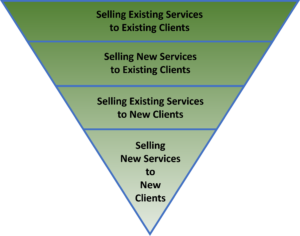We are seeing demand for legal services remains somewhat flat if not a very slight uptick in demand. New entrants into some of the markets outside of the U.S. and the Big Four accounting firms are focused on grabbing as much of their client share as possible. It will be more important now to focus on talent and client retention (which by the way may be tied together in some ways). This article will focus on client retention, but many of the same principles apply to talent retention. One of the exciting aspects about competition is it forces firms to try new strategies and focus even more on business development and client relationships. There are some strategies which have proven successful year over year. This helpful graphic demonstrates which business development strategies will yield the best results.

Selling existing services to existing clients should not need a lot of discussion. Yet, clients continue to say they seldom see their outside counsel in person, they don’t often hear from them unless there is a new matter they are working on, and they rarely proactively let them know what else the firm may do for them. These comments cover the first and second sections of the above graph and as it shows, provide the more significant opportunities for driving revenue to the firm. During the recent Thomson Reuters Legal Executive Institute and Georgetown Law’s “State of the Legal Industry” webinar, Fender Music Company’s GC Aarash Darroodi stated, “we have 600 outside counsel we work with in every single country in the world. How many of them contact me proactively to ask me about my business? Zero.”
An Intapp data scientist stated their research data supports not only are clients more likely to buy more services, they will then be less likely to leave a firm. She notes: “Specifically, if there are 3 or more practices at play, the client has a higher propensity to buy more legal services. We call this the Rule of 3.” This is important to know because the data shows that connecting with clients and growing the firm’s ‘share of wallet’ is a critical tactic to ward off competitive hits on a firm’s client base. Further, building business across a client organization means building a larger group of contacts at that client and if one contact leaves it doesn’t mean the firm is now in jeopardy of losing the client. Fix the compensation system if it does not reward collaboration and client expansion and firms will have a much greater success at revenue growth. This requires leadership.
Where does a firm start when it comes to defining and implementing a client retention strategy?
Begin by identifying and selecting a group of initial clients using these criteria:
- Succession planning. Building strong client relationships takes time. For partners who are retiring within the next five years, we recommend the firm begin to introduce a new relationship partner or team to the client. Building on input received from the client, the potential new team or succeeding relationship partner will have an opportunity to use the feedback and data from the interview as a foundation from which to continue to build a strong relationship with the firm.
- Threatened client relationships: These relationships have several identifying factors which include:
- A decline in fees received over a two or more year(s) timeframe
- Significant clients who are most likely the target for other law firms, therefore creating a competitive threat to the relationship
- Clients where a less than favorable outcome from a deal, a case or a matter causes uncertainty for the firm about its future relationship with the client
- Little integration with the firm overall—one client contact and/or one firm contact—where the relationship needs to be expanded both sides (e.g. if the client contact leaves, what happens to the client and if the firm partner leaves, what happens to the firm’s relationship with the client)
- Retiring responsible partner or retiring client contact (related to 1 above)
- Significant clients: Firms are built on strong client relationships. While we recommend that relationship partners and members of the firm’s management team visit these clients annually, time does not always permit these visits. And yet, these clients’ views about what they value, about the relationship they have with the firm and its contact partners and lawyers, and about their perceptions on how the relationship may be made even stronger are critical to the continued care and growth of these relationships. Leveraging these good relationships into loyal advocates requires not only the firm’s focus, but also inclusion of the voice of the client in the process.
- Clients with potential for growth: Some clients are very specific about the firms with whom they work for particular situations including type of legal services needed, jurisdiction, and existing strong and loyal relationships. Not all clients have potential for growth. Understanding the client’s philosophy and perceptions in an objective manner can uncover the potential for the relationship to grow. Studies have shown that many clients are just somewhat satisfied with their outside counsel and they have not switched because it’s easier to stay with the status quo. Building strong relationships, starting with a client interview process, can identify potential opportunities for client growth and therefore increased share of wallet and ultimately more loyalty in the relationship from the client.
- Clients in potential growth markets–Building on existing strengths with smaller clients: Many firms have a client list focused on certain market segments. To build the firm’s success in these industries and segments, there will be opportunities to concentrate on and grow those (sometimes smaller) clients who have already worked with the firm. This provides the firm an opportunity to expand its presence to potentially become a “go to” firm in specific market segments.
Once the firm has identified an initial group of clients for retention and growth, we recommend a client plan (in business it’s called a Strategic Account Plan) for each client be developed. (For a copy of this form, please email us at scoulter@lawvision.com.)
Next steps are to identify all existing relationships the firm has with each client and those individuals with whom the firm would like to develop relationships or must develop relationships (e.g., crucial board member(s), CFO, CEO, GC, etc.) The existing relationship partner(s) and client contact will do well to create a setting for a meeting of two or three individuals from each side and hopefully at least two peer levels (for building ongoing relationships with next generations).
Once key relationships have been identified it will be most critical to understand the clients’ key goals and business objectives. Simply ask and the client will be happy to share their annual goals and many are willing to share their strategic plan with outside counsel. Invite the client to come to the firm and meet with the relationship team to discuss these issues or ask to meet with the client and learn more about their growth strategies (will they grow by acquisition? merger? new business lines? shedding business lines?) all important and ‘need to know’ information if the firm is to be a business partner with the client and continue to offer value. Helping a client with their goals and objectives as a business by being proactive and offering value and solutions is a significant win for any firm that wants to retain and grow client share. Clients must be involved and provide insight and input into the firm’s strategic account plan for that client.
Once the key goals are identified with the client, the firm will then want to focus its efforts on adding value. For example, if a bank’s strategy is to grow through acquisition in new jurisdictions, then the legal work involved would be M&A, due diligence on any IP, L&E work and other potential areas related to these acquisitions. Our value proposition may then be to introduce the client to potential acquisitions and contacts. And, to help to identify the legal issues the firm may assist with in advance to avoid any added last-minute costs.
Safeguarding clients from the competition needs to be a key strategy for any firm. A strategic account strategy will also help to retain talent important to firm relationships. The account strategy will bring new life to client/firm relationships and new energy to growing significant firm revenue.
——————————————————–
Silvia Coulter is a principal with LawVision and an expert in helping firms with strategies for driving and leading revenue growth. She may be reached at scoulter@lawvision.com. A copy of her co-authored book, “SAM-Legal: Turning Key Clients into Strategic Accounts, may be purchased here.
Posted In


